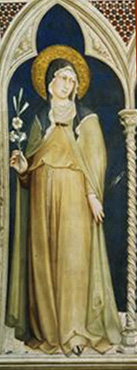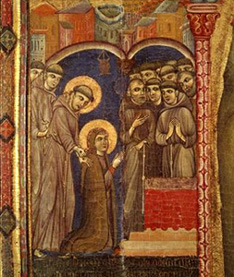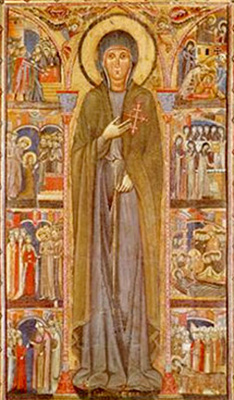 |
The Saint of the Day
St. Clare of Assisi – August 12
Prof. Plinio Corrêa de Oliveira
Biographical selection:

St. Clare of Assisi
Simone Martini, 13th century
|
When Francis of Assisi was preaching at St. George Church, a young lady from a noble family was listening to him with her mother and sister. Claire listened to those words and understood that St. Francis should be the guide of her soul. She confided this desire to her aunt, who went with her to St. Mary of the Angels to speak with St. Francis. Who can say what happened in the soul of the Seraphic Father during that first interview with the woman who would be his assistant in the task Heaven had designed for him to accomplish?
Francis revealed to Clare the beauties of the Celestial Spouse and the excellence of virginity. Then he described to her what he cherished the most in his heart: the power and the charm of poverty and the need for penance. Clare listened, astounded and enthused, and the divine appeal touched her heart. In a short time her decision was made. She would break all the bounds that linked her to earth and consecrate herself to God.
On the evening of Palm Sunday, March 17, 1212, she secretly left her father’s house and with some companions headed toward St. Mary of the Angels, the Church of the Portiuncula. St. Francis and his brothers met them along their way with torches and led them into the church. On that night the spiritual marriage of St. Clare took place. Francis asked her what she wanted, and she answered: “I want the God of the Manger and of Calvary. I desire no other treasure or inheritance.”
While Francis was cutting her hair, she delivered over all her precious jewelry and ornaments, and received the rude habit, cord, and humble veil and consecrated herself entirely to God.
Comments of Prof. Plinio:

St. Clare received by St. Francis
Below, St. Clare, in S. Chiara Church, Assisi
 |
One can admire the beauty of the scene. In the small medieval town of Assisi, a cortege of young ladies flees the home of their families, who want to impede their sacrifice. Silently and cautiously they walk through the winding streets of Assisi so as not to raise any attention. They leave the town and in the fields that separate Assisi from the Monastery of St. Mary of the Angels they meet another cortege. This second cortege is even more heavenly than the first. It is St. Francis of Assisi, who was another Christ on earth, who was even similar physically to Our Lord Jesus Christ.
Carrying torches, St. Francis and some of those saints who helped him found the Franciscan Order walk to receive those virgins. The corteges unite and enter together into the Church of Our Lady. The group gathers inside it in a circle. St. Claire renounces everything.
Then St. Francis cuts her hair as she takes the definitive step from which the Order of Poor Clares would be born. Upon that step depended the entire Second Order of Franciscans, which gave so many saints for the Catholic Church and glory to God through the centuries.
St. Claire left everything to enter a convent at a time when, in many respects, the Church was in her apogee. Today, we are witnessing the House of God cracked, the dignity of the ministers of God dragged into the mud, the veil of religious women gone, religious life disintegrated. Does this tragic spectacle leave us indifferent? Are we more concerned about our job, making money, buying a new car and new clothes, or acquiring more comforts for our home? If so, where is our faith? What do we believe in? What do we take seriously?
Only when a Catholic completely lacks seriousness can he place his personal life on the same level with the extreme sorrow this religious situation represents to the Catholic Church. Actually, it represents another Passion of Our Lord Jesus Christ. Today the Church is crucified. She does not die because she cannot die; otherwise she would have already expired.
So, on this day of St. Clare, let us imitate her dedication and confirm our commitment to offer our lives to fight against Progressivism in the Church, which is the worst enemy she has ever had throughout time. Never has a cause had so few persons to fight for it. This is enough to characterize it as the most glorious fight in History.
Speaking about those pilots who fought the Battle of London and saved the city from the Nazi bombardments, Churchill said: “Never was so much owed by so many to so few.” On the Final Judgment, Our Lady will certainly say something similar about those who fight for her now.
Let us ask Our Lady and St. Clare to imbue our souls with this spirit of dedication to the cause of Holy Mother Church.


  | | Prof. Plinio Corrêa de Oliveira | |
The Saint of the Day features highlights from the lives of saints based on comments made by the late Prof. Plinio Corrêa de Oliveira. Following the example of St. John Bosco who used to make similar talks for the boys of his College, each evening it was Prof. Plinio’s custom to make a short commentary on the lives of the next day’s saint in a meeting for youth in order to encourage them in the practice of virtue and love for the Catholic Church. TIA thought that its readers could profit from these valuable commentaries.
The texts of both the biographical data and the comments come from personal notes taken by Atila S. Guimarães from 1964 to 1995. Given the fact that the source is a personal notebook, it is possible that at times the biographic notes transcribed here will not rigorously follow the original text read by Prof. Plinio. The commentaries have also been adapted and translated for TIA’s site.
|
Saint of the Day | Home | Books | CDs | Search | Contact Us | Donate

© 2002- Tradition in Action, Inc. All Rights Reserved
|
 |

|